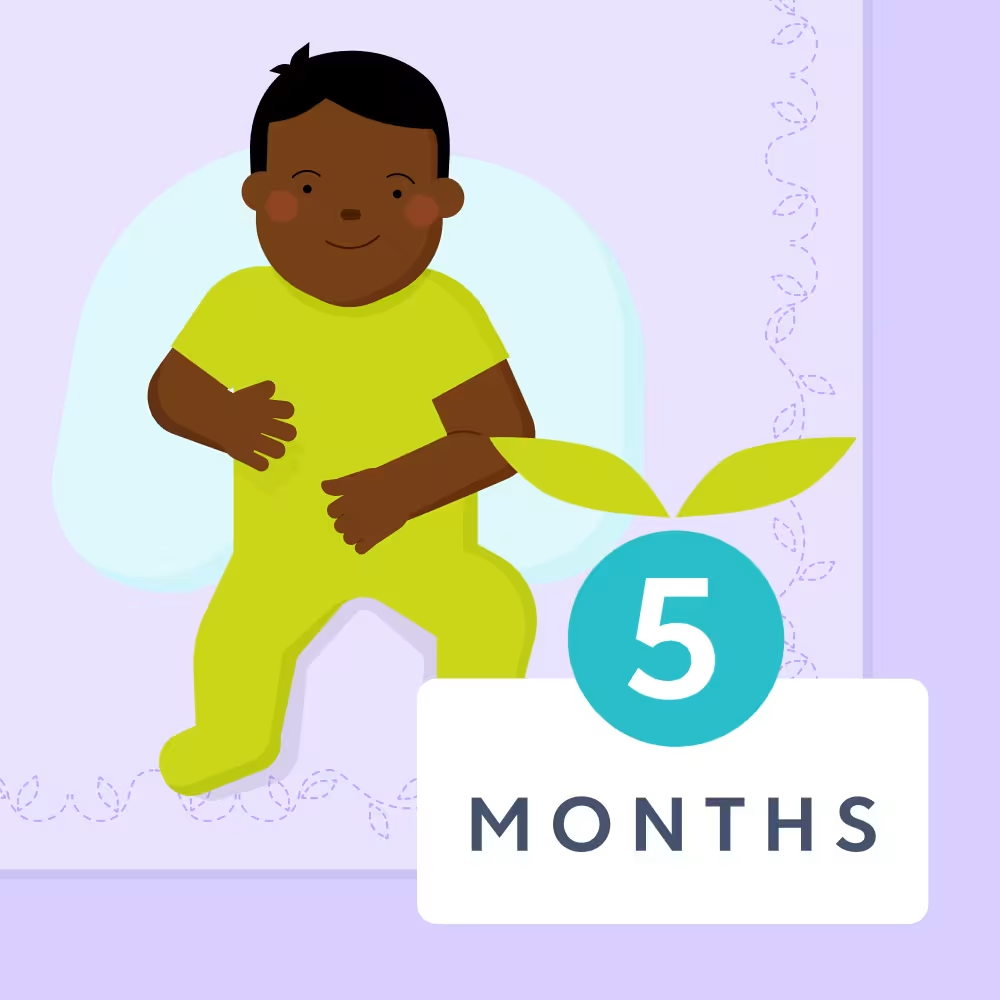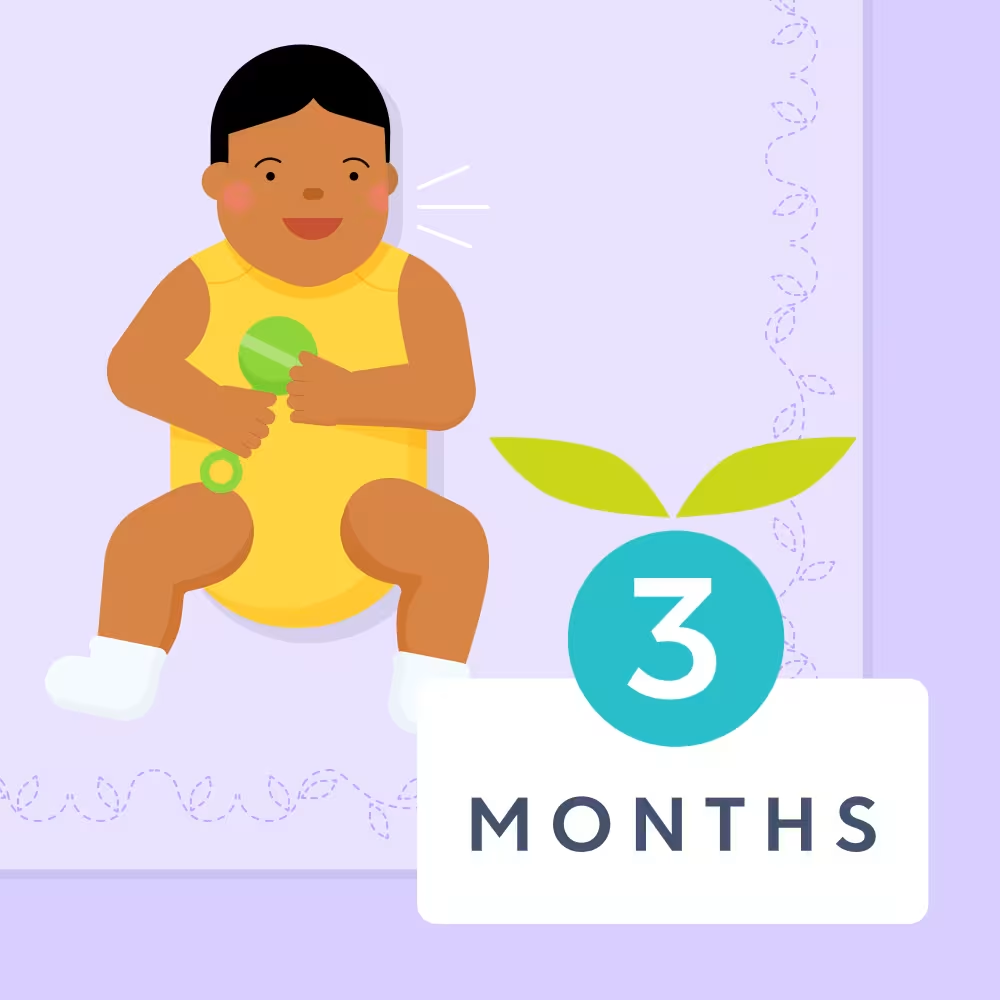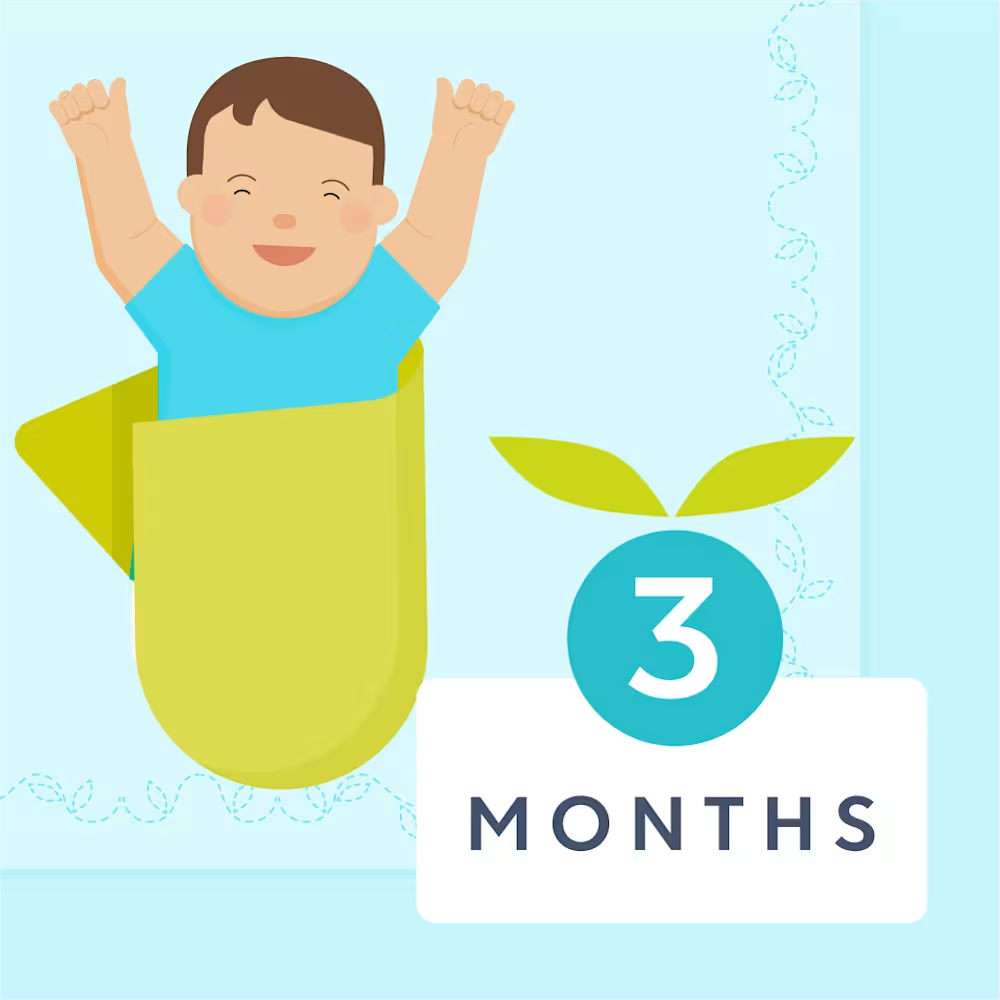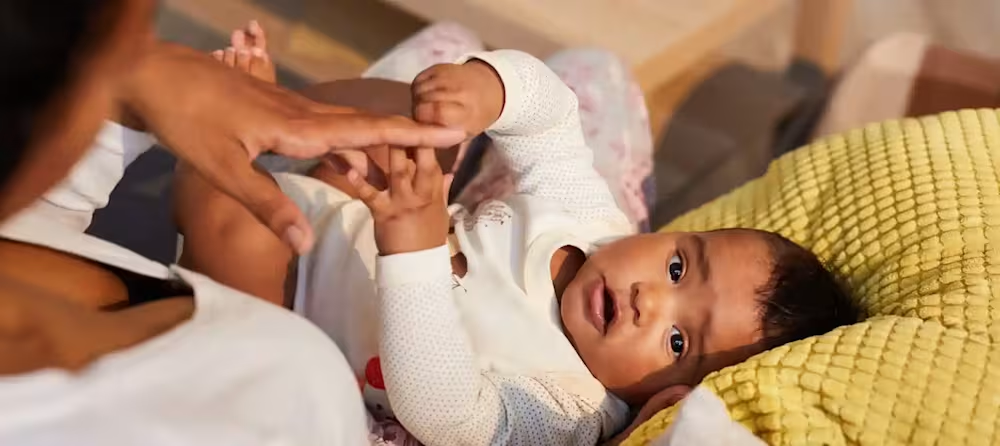4 month old baby milestones: Development, growth, speech, language
Updated Dec 29, 2025

Babies at 4 months are working on exciting skills as they learn and grow every day. At this age, they’re learning to interact with people and objects in new ways by smiling, cooing, reaching for toys and putting them in their mouth, and more.
In this article, we’ll cover what to expect when it comes to 17 - 21 week old babies, provide you with a handy 4 month old development checklist, and provide useful tips to help ensure your little one is reaching appropriate milestones.
Editor's note
When we discuss babies and development at Huckleberry, we use their adjusted age (vs. actual age). It’s normal for little ones to reach milestones at different times, as there's a wide spectrum when it comes to how fast babies grow and develop. However, most children will reach these milestones around 17 - 21 weeks. If you have any concerns or questions about your child’s development, reach out to their healthcare provider.
Table of Contents
4 month old baby milestones at a glance
Development:
4 month olds are working on exploring the world in their own ways. Between 4 - 5 months, they’re usually able to reach and grab items and then bring them to their mouth, which gives them exciting new sensory information. They’re also getting stronger thanks to tummy time and floor play, which will help set them up for success with future motor milestones like rolling and sitting up.
Little ones are also working on their communication skills between 17 - 21 weeks. They’re likely turning towards sounds, like a familiar person’s voice, and offering up adorable coos and smiles when they’re content. If they’re not happy, they might be trying to let you know what’s wrong at this age by changing up their cry to indicate different needs.
Sleep:
We recommend aiming for about in a 24-hour period. This usually includes 3.5 - 4.5 hours of daytime sleep split up into 3 - 4 naps. If your little one is taking longer naps, they may do well with a 3-nap schedule. Your baby will likely take 4 naps per day if their naps are on the shorter side. If this is the case, try not to feel discouraged by short spurts of daytime sleep. It’s common to see 30 - 45 minute naps at this age.
Note that these recommendations are general guidelines and monitoring your child’s energy levels and mood is also important when it comes to making sure your baby is getting enough sleep. Some children have higher or lower sleep needs, so don’t stress about the overall number if your baby seems well-rested.
You may also be wondering about the dreaded “.” Interestingly, it isn’t really a regression at all. It’s a period of development and a biological change in a baby’s stages and cycles of sleep. At around 4 months, babies begin to have additional cycles of light sleep and deep sleep, similar to an adult. This is a sign of maturation instead of a temporary phase to get past.
While this change happens for all babies, it may not always negatively impact sleep. However, some signs of the 4 month sleep regression can include sudden worsening of night sleep, increased fussiness at sleep times and a harder time settling for sleep, disrupted naps and less daytime sleep, and distracted daytime eating. If your baby is experiencing any of these symptoms, you’re not alone!
Your baby might start sleeping better if they follow an age-appropriate , can developmentally link sleep cycles, and learn how to fall asleep independently. Consider submitting for a sleep plan through if you’d like step-by-step guidance tailored to you and your baby.
Feeding:
Your baby should still meet all their nutritional needs with breast milk and/or formula at 4 months old. They may signal that they’re hungry by putting their hands near their mouth [].
Solids are on the horizon! However, the American Academy of Pediatrics [] advises waiting until 6 months of age to start giving your baby solid foods. Between 17 - 21 weeks, your little one may be showing interest in the foods you eat and working on the skills necessary to start eating solids [] — like being able to sit in a high chair with good head control, bringing objects to their mouth, and trying to grab small objects.
Growth:
Between 4 - 6 months, most babies gain an average of 1 to 1.25 pounds per month. Around 4 - 5 months, their birth weight has usually doubled []! On average, a baby will also grow .5 - 1 inch in height between 17 - 21 weeks. Their head will likely grow around .5 inches too.
Keep in mind your baby may grow more or less than this over the course of a month. That’s normal! Your child’s doctor will check that they’re growing at a regular pace by plotting their height and weight on a growth chart at every visit. That way, they can quickly pinpoint any trends that need attention. Bring up any concerns you may have about your baby’s growth and development with their pediatrician.
4 month development milestones
Physical development
Gross motor skills
Head control: An expected 4 month gross motor milestone is the ability to hold their head steady without support while being held.
Rolling: Around 4 months your baby may start to roll over. Little ones typically roll from their tummy to their back first. Sometimes this happens by accident when a baby is doing tummy time and the weight of their head causes them to roll over. At 4 months this may be happening more intentionally as well.
Often a baby will practice rolling from their tummy to back for a month or two [] before being able to roll from their back to tummy. By around 6 months [], most little ones are able to roll both ways.
Tummy time: Your little one is getting to be a tummy time pro at 4 months []! At this age, most babies are able to lift their heads up 90 degrees while doing tummy time and maintain a centered position thanks to increased neck strength.
They can usually also push up onto their forearms with their chest lifted and their elbows beneath their shoulders. These skills allow curious 4 month olds to track toys, faces, and sounds while spending time on their belly.
Fine motor skills
Reaching and grabbing: 4 month fine motor milestones mean your baby likely has busy hands! At this age, they’re often reaching and grabbing [] at everything — toys, blocks, dangling items, etc. They’re also working on holding onto a toy when you put it in their hand.
Hands to mouth: Babies are usually able to bring their hands to their mouth [] at this stage due to improving hand-eye coordination. They often chomp on their fingers and anything that’s placed in their hands! Because of this, be sure to keep small objects that could be choking hazards out of reach.
Social development
Smiles and laughs: Get those cameras ready — your baby at 4 months is likely smiling on their own [] to get your attention. And they’ll probably continue “asking” for attention by looking at you, moving, or making sounds. How cute is that? They’re probably also starting to chuckle at this age, but probably not fully laughing quite yet.
Cries: 4 month old emotional development often means they will use their cries to help differentiate their needs. Cries at this age will start to sound different [], depending on if they’re tired, hungry, or possibly in pain.
Speech development
Cooing: Expect to hear some adorable new sounds [] from your 4 month old. They may make cooing sounds like “ooo” and “ahh” at this age. They might even “respond” to you with sweet sounds when you talk to them.
Attention to sound: Infants at 4 months can typically turn their heads towards the sound [] of your voice.
17 to 21 week old development milestones checklist
Most babies will hit the following milestones by 17 - 21 weeks, though this might not always be the case. Little ones learn and grow at different rates and there’s a wide spectrum of normal when it comes to development. However, if you notice any red flags or potential delays in 4 month developmental milestones, consider consulting with their healthcare provider.
Hold head steady without support
May roll tummy to back
Lift head up 90 degrees while doing tummy time
Reach and grab objects
Hold a toy placed in their hands
Bring hands to mouth
Smile to get your attention
Cry to indicate different needs
Make cooing sounds like “ooo” and “aah”
Turn their head towards sounds
What are 4 month old development red flags?
While every baby develops at their own pace, certain signs may be worth bringing up with your baby's healthcare provider. At around 4 - 5 months, talk to your pediatrician if your baby []:
Doesn’t coo or make sounds
Isn't watching things as they move
Has trouble moving eyes (one or both) in all directions
Doesn’t smile socially (at people)
Is unable to hold head steady
Doesn’t bring things to mouth
Doesn’t press down with their legs when their feet touch a firm surface
3 development tips for 4 months
Tip | Why it helps | What to try |
|---|---|---|
Smile and chat | Responsive, happy interactions help build early language skills and teach conversational back-and-forth. | Make eye contact, smile, and “chat” by responding to their sounds with your own. Keep it playful and expressive. |
Let your baby “mouth” and chew safe objects | Mouthing objects is a key way babies learn about texture, temperature, and shape — all crucial for sensory development. | Offer safe items like teething toys, soft cloths, or silicone rings. Keep sharp, hot, or choking hazards far away. |
Repeat your baby’s name often | Hearing their name helps babies learn sound patterns and supports early language recognition. | Use your baby’s actual name during play, diaper changes, and feedings — nicknames can stay, just mix both in! |
Find more details below:
Tip #1: Smile and chat with your baby
While your little one won’t understand the words you’re saying for quite some time, you can help lay the foundation for their language development by smiling and interacting with them. Make it fun! This teaches them [8] about back-and-forth conversations and your happy demeanor can encourage your baby to continue engaging and responding with their own sounds too.
Tip #2: Get mouthy
Babies are discovering the world at this age. They’re starting to put everything in their mouth — that’s how they explore! While it can be stressful for parents, exploring through touch and taste [] is key for your little one’s brain development. Just be sure to keep anything that’s sharp, hot, or small enough to choke on far out of reach.
Tip #3: Say my name
You probably have a whole list of cute nicknames for your baby and that’s great! Try to call them by their name too to help them learn it. One study [] showed that babies recognize the sound pattern of their own name as early as 4.5 months!
Activities for a 4 month old baby
1. Tummy time
Help your baby move, learn, and explore by having them spend plenty of time on the floor and their tummy daily.
Aim for about 90 minutes total [] of tummy time per day for 4 month olds.
Tummy time helps strengthen the back, arm, and neck muscles needed for upcoming motor skills like rolling and sitting up.
Spending time on the floor [] also increases their independence and confidence.
Note that you should always closely supervise your baby during these activities, but you can start to give them the ability to play and problem-solve on their own.
2. Read books with big, bright pictures
At 4 months, babies tend to like looking at bright patterns and color variations [] as their vision develops.
Your child will likely enjoy reading books with large, bright objects for them to look at.
Try pointing out and naming the things you see in the book and narrating what’s happening to boost their thought and speech development [] too.
Caring for a sick child at 4 months
It's so hard when you have a sick baby — even if it's just the sniffles. The following tips may help when your little one's under the weather. That said, if you notice any concerning symptoms or just feel like something’s off, call your baby’s healthcare provider. You know them best and it's usually best to err on the side of caution.
Hydrate: Continue exclusively offering breast milk and formula to your baby. Offer smaller, more frequent feeds if necessary if they're not tolerating full feeds while they're sick.
Ease congestion: To help a , try using a cool-mist humidifier, gentle suction, and/or saline drops. Clearing up congestion and offering extra support before sleep times can help them get the rest they need to feel better.
Watch for fever: If your child has a fever for more than 24 hours or their temperature rises above 104°F (40°C) repeatedly, call their doctor right away [].
Be flexible with sleep: Your little one may need more sleep and/or have difficulty sleeping when they're not feeling well. Sleep may still be a bit all over the place at 4 months and it may be even trickier during an illness.
Offer extra comfort: Your baby may be even harder to put down while they're feeling yucky. This can be taxing for caregivers too! Tap in a partner or a close friend or family member when possible.
When to seek help
If your child has a fever for more than 24 hours or it reaches above 104°F (40°C), call their doctor right away. These can be signs of a more serious infection or illness and it's best to rule out anything that needs medical attention.
In general, if something feels off or you’re worried about how your child looks or acts, it’s safest to check in with their doctor. And if you already talked to them but symptoms appear worse, that’s a good time to check back in too.
Takeaway: Development milestones for 4 month olds
It’s so exciting to watch your child learn and grow between 4 - 5 months! At this age, your little one is likely holding their head steady without support and working on strengthening their muscles during tummy time each day. They may even start rolling from tummy to back this month.
4 month milestones for the baby also include reaching and grabbing for all sorts of toys and objects and then likely bringing these items to their mouth. Mouthing helps babies learn about the world!
4 month old speech milestones include big smiles and cute coos! Expect your baby to start making “ooo” and “ahh” noises around 17 - 21 weeks. They will also likely turn towards the sound of your voice at this stage.
There’s a wide spectrum of normal when it comes to 4 month old milestones. It’s normal if your little one isn’t doing all of these things between 17 - 21 weeks as babies reach milestones at different times. That said, if you notice any 4 month old milestone red flags or delays, check in with your child’s healthcare provider.
If you're curious about what lies ahead in the coming month, glimpse into the future to see what you might experience once your baby is a . Take a look back at how far your baby has come by revisiting what .
17 - 21 week old developmental milestones FAQ
Share article:
Note: The content on this site is for informational purposes only and should not replace medical advice from your doctor, pediatrician, or medical professional. If you have questions or concerns, you should contact a medical professional.
16 Sources
Table of Contents
Share article:








